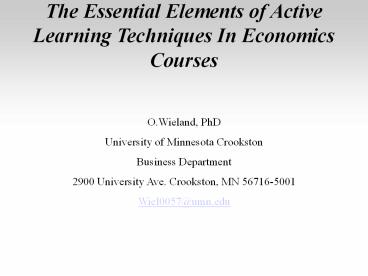Teaching Economics: Approaches to Instructional Design PowerPoint PPT Presentation
1 / 15
Title: Teaching Economics: Approaches to Instructional Design
1
The Essential Elements of Active Learning
Techniques In Economics Courses
O.Wieland, PhD University of Minnesota
Crookston Business Department 2900 University
Ave. Crookston, MN 56716-5001 Wiel0057_at_umn.edu
2
Outline
- The author analyses best practices that should be
part of teaching economics courses. - Challenges
- Purpose of Research
- Background
- Good Pedagogy
- Creating a Learning Environment
- Principles of Instructional Design
- Key Elements of Active Learning Techniques
3
Challenges
- Conceptual Difficulty of the Subject
- The Nature of the Courses
- The Student population
- The Students Background and Preparation
- Time Constraints (constant feedback)
- Technology Availability (access to technology)
- Class Size
- Delivery Mode In Class or Online?
4
Purpose of Research
- Analyze synthesis of learning activities for
teaching Economics. - Develop a theoretical approach for analyzing
instructional design - Planning
- Implementation
- Reflection
5
Background/Related Work
- Henderson(1985), Wickens,(1996), Darcy(1997)
- Support, nurture intellectual development
- Learning is student-centered.
- Learning occurs in small student groups.
- Teachers are facilitators or guides.
- Realistic scenarios (from media) are the
organizing focus and stimulus for learning. - Student feedback mechanisms are the vehicle for
the development of critical problem-solving
skills. - Essential and problem solving skills are acquired
through individual and group learning. - Technology incorporation/availability.
- Class size/design
6
An Approach to Good Pedagogy
- Duckworth(1992)
- Students...allowed to do their own learning
- Presenting the LEARNING BY TEACHING
- Inquiry and Problem Solving Focused Instruction
- Controversy Element Critical Thinking
- Knowledge Application/Skill Building
- Varied and Continuous Assessment
- Student Progress
- Teacher Effectiveness
7
An Approach to Good Pedagogy
- Data from over 400 course IDEA course
evaluations - IDEA diagnostic Form
- Includes evaluation of 20 effective teaching
methods ( based on Chickering's research) - Regression analysis to see which of the 20
teaching methods predict Excellent Course rating
8
IDEAS
9
Active Learning Methods
Brain Storming
Think -pair- Share
Reaction to Video
Class-Game
Knowledge and Concept Formation
Experiments
Short Written Exercise
Discussion
Developing Skills
Collaborative Learning Groups
Case Studies
Debates
Learning By Teaching
- Application
10
Learning Environment as Part of Instructional
Design
- ..in which the student
- Experiments, manipulates, seeks own answers
- Reconciles learning with others
- Is presented with content relevant and is asked
to provide feedback - ..in which the instructor
- Establishes a rapport with the students
- Encourages student involvements and collaboration
- Stimulates intellectual efforts
- Provides frequent feedback
11
Principles of Instructional Design
- Cooperative learning methods
- Goal oriented
- Informed learning outcome
- Accountability
- Measurable impact
- Student centered learning activities
- Motivational component as a foundation of student
success
12
Components of Instructional Design
- Conceptual Relationships
- May be described as student-instructor
communication (student guided and instructor
guided) to create meaningful relationships among
concepts - Pedagogical Moves
- Examine the structure of the course as a series
of pedagogical approaches that affect learning
outcomes
13
Elements Of Good Pedagogy
- There are five main elements which support the
idea of intellectual stimulation and achieving a
high learning outcome - Cooperative Learning/Student Centered
- Real Life Application
- Active Learning Strategies
- Feedback
- Technology
14
Element I Cooperative Learning/Student Centered
- Ensure cooperative learning mode
- Align curriculum with leaning outcome
- Include student facilitation process through
classroom discussion - Instructional environment is student centered
- Diversified mode of information delivery
15
Element II Real-life Application
- Knowing/understanding Economics theory, concepts
- Real life examples
- Using learning outcome as a basis for
instructional planning - Using best active learning practices
- Exposure to professionals in the field
- Visual emphasis on information delivery
16
Element III Active Learning Strategies
- Develop/provide instructional support materials
that challenge students to examine diverse views
of the content being studied - Establish leadership roles and student discussion
facilitators - Provide the foundation for active engagement and
student involvement in the learning process - Reinforce the learning material and enhance
student comprehension
17
Element IV Feedback
- Multiple approaches to assessment
- Timely feedback is essential to student
performance improvement - Identify and eliminate misconceptions
- Provide a path for student/teacher interaction
18
Element V Technology
- Provide and encourage experiential use of
instructional technology ( Aplia, Moodle,
Immediate Response Clicker System) - Support student access to a variety of technology
tools - Integrate the use of technology across active
learning methods
19
Bibliography
- Serife KARAKOC, Nurettin SIMSEK. (May 2004) The
effect of teaching strategies on the usage of
learning strategies. Educational Sciences
Theory Practice 4(1) 116-121 - Walter D.Davis, Neal Mero, Joseph M. Goodman.
(2007) The interactive effects of goal
orientation and accountability on task
performance. Human Performance ,20(1), 1-21 - Crystal Kuykendall. (1992) From rage to hope
Strategies for reclaiming Black Hispanic
students. 1992. 1(2) - Richard C. Overbaugh, Shin Yi Lin. (2006) Student
characteristics, sense of community, and
cognitive achievement in web-based and lab-based
learning environments. Journal of research on
technology in education, 39(2),205-2223 - Sharon D. Harsh and Eric Kincaid. (Winter 2007)
Global education strategies developing
macrostructures for understanding complex
information. The Delta Kappa Gamma bulletin - Daniel R. Smith, David F. Ayers. (2006)
Culturally responsive pedagogy and online
learning Implications for the globalized
community college. Community college journal of
research and practices, 30 401-415
20
Bibliography
- M. David Merrill. (2007) A task-centered
instructional strategy. Journal of research on
technology in education, 40(1), 5-22 - Charles Henderson, Andrea Beach, and Michael
Famiano. (2007) Diffusion of educational
innovations via Co-teaching. American Institute
of physics - 9. David Wickens. (1973) Piagetian theory as a
model for open systems of education. Piaget in
the classroom. Basic Books Inc., Ch.8 ,
179-1981. Henderson C., Beach A, and Famiano M..
(2007) Diffusion of educational innovations via
Co-teaching. American Institute of physics

